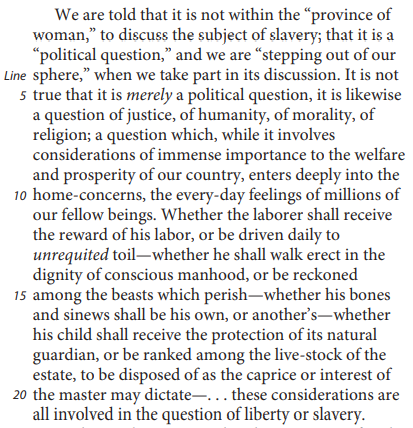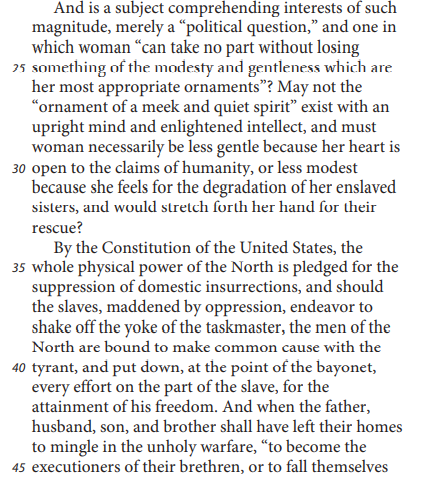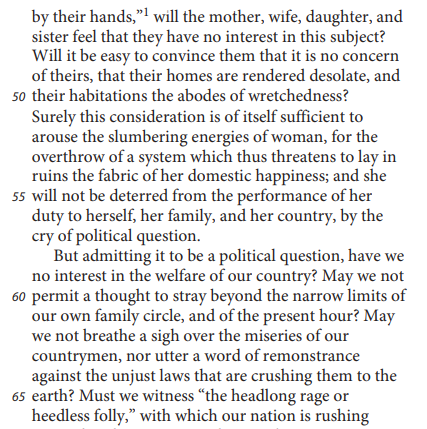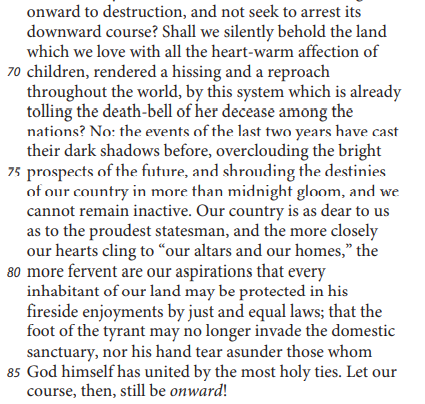SAT (Scholastic Assessment Test) is a standard test, used for taking admission to undergraduate programs of universities or colleges of the United States. SAT is developed and published by the College Board, an organization in the United States, administered by the Educational Testing Service. In this article of AKVTutorials, you will get SAT Reading Sample Questions Test 44 | SAT 2024 Online Tutor AMBiPi.
SAT Reading Practice Passage
This passage is adapted from a speech delivered in 1838 by Sara T. Smith at the Second Anti-Slavery Convention of American Women.




SAT Reading Comprehension Practice Test Questions
SAT Practice Test 44 Question No 1
Smith’s main purpose in the passage is to
Option A: accuse fellow abolitionists of overlooking the contributions that women have made to the movement.
Option B: argue that the causes of abolition and women’s rights are continuations of the spirit of the American Revolution.
Option C: make the case that women’s rights are meaningless while slavery exists.
Option D: encourage women to see their participation in the abolitionist cause as just and important.
SAT Practice Test 44 Answer No 1
Show/Hide Answer
Option D :
In the passage, Sara T. Smith addresses the Second Anti-Slavery Convention of American Women. In the second sentence of the first paragraph, Smith states that confronting slavery is “a question of justice” and that it involves “considerations of immense importance to the welfare and prosperity of our country.” In the third paragraph, Smith argues that women shouldn’t be deterred from participating in the abolitionist cause. In the last paragraph, she argues that women “cannot remain inactive” in confronting slavery as “our country is as dear to us as to the proudest statesman. . . . Let our course, then, still be onward!” Therefore, Smith’s main purpose in the passage is to encourage women to see their participation in the abolitionist cause as just and important.
Choices A and C are incorrect because Smith doesn’t accuse fellow abolitionists of overlooking the contributions that women have made to the movement (choice A) or make the case that women’s rights are meaningless while slavery exists (choice C). Choice B is incorrect. Although Smith quotes the Declaration of Independence in the third paragraph, the main purpose of the passage isn’t to argue that the causes of abolition and women’s rights are continuations of the spirit of the American Revolution.
SAT Practice Test 44 Question No 2
Which statement provides the best description of a technique that Smith uses throughout the passage to advance her main point?
Option A: She presents claims in the form of rhetorical questions that mostly have implicit negative answers.
Option B: She criticizes her opponents by quoting self-contradictory remarks they have made.
Option C: She illustrates each of her central ideas with an emotionally powerful anecdote.
Option D: She emphasizes the reasonableness of her views by presenting them as though they are universally held.
SAT Practice Test 44 Answer No 2
Show/Hide Answer
Option A :
Throughout the passage, Smith poses questions that aren’t answered explicitly until the last paragraph, but the leading tone of the speech makes it clear that the implied answer to these questions is “no.” In the second paragraph, Smith questions her critics’ claim that upholding humanitarian values undermines conventional feminine virtues. In the third paragraph, she wonders how women can “have no interest” in the subject of slavery when it could lead to the destruction of their families through war. In the last paragraph, she asks women numerous questions and then answers them with a “no.” Thus, a technique that Smith uses throughout the passage to advance her main point is to present her claims in the form of rhetorical questions that mostly have implicit negative answers.
Choice B is incorrect. Although Smith questions the assertions that her opponents made, she doesn’t criticize her opponents themselves by quoting self-contradictory remarks they have made. Choice C is incorrect. Although Smith makes use of vivid language and imagery throughout the passage, she doesn’t illustrate each of her central ideas with an emotionally powerful anecdote. Choice D is incorrect. Although it is implied that Smith considers her views to be reasonable, she doesn’t present them as universally held.
SAT Practice Test 44 Question No 3
How does Smith develop her argument about slavery as a “political question” (line 3) throughout the passage?
Option A: She claims the designation is an outdated one and then offers alternative definitions.
Option B: She dismisses the designation as too narrow but then demonstrates its relevance to her audience.
Option C: She contends that the designation has become trite and then invites her audience to revitalize it.
Option D: She describes the meaning the designation has for men and then challenges women to embrace it.
SAT Practice Test 44 Answer No 3
Show/Hide Answer
Option B :
In the first sentence of the passage, Smith introduces the argument that slavery is a “political question” and therefore not “within the ‘province of woman.’” In the second sentence, Smith voices her opposition to this argument: “It is not true that [slavery] is merely a political question, it is likewise a question of justice, of humanity, of morality, of religion.” In other words, slavery is too broad a problem to be classified solely as “political,” in Smith’s view. However, in the fourth paragraph, Smith returns to the political aspect of the argument at hand by addressing how women must engage in the subject of slavery on a political scale. She argues that “admitting [slavery] to be a political question” doesn’t mean that women have “no interest in the welfare of our country,” as women must criticize slavery and its “unjust laws” and seek to stop the nation’s “downward course” by choosing to not “remain inactive.” Therefore, Smith develops her argument about slavery as a “political question” throughout the passage by dismissing the designation as too narrow but then demonstrating its relevance to her audience.
Choice A is incorrect. Although Smith does offer alternative ways of defining the problem of slavery, she doesn’t claim that the designation of slavery as a “political question” is outdated, but rather that it is insufficient. Choice C is incorrect because Smith doesn’t contend that the designation of slavery as a “political question” has become trite, nor does she invite her audience to revitalize it. Choice D is incorrect. Although Smith’s argument is intertwined with questions of gender roles, she doesn’t describe the meaning the designation of a “political question” has for men and then challenges women to embrace it.
SAT Practice Test 44 Question No 4
Which choice best summarizes the first paragraph?
Option A: Smith explains a conventional viewpoint and presents evidence supporting it.
Option B: Smith rejects a claim and elaborates on her reasons for doing so.
Option C: Smith introduces her subject and provides historical background for understanding it.
Option D: Smith identifies a problem and proposes steps to remedy it.
SAT Practice Test 44 Answer No 4
Show/Hide Answer
Option B :
In the first sentence of the passage, Smith relays a claim: “We are told that it is not within the ‘province of woman,’ to discuss the subject of slavery; that it is a ‘political question,’ and we are ‘stepping out of our sphere,’ when we take part in its discussion.” In the next sentence, Smith rejects this claim: “It is not true that it is merely a political question, it is likewise a question of justice, of humanity, of morality, of religion.” She then argues that the subject of slavery “involves considerations of immense importance to the welfare and prosperity of our country, enters deeply into the home-concerns, the every-day feelings of millions of our fellow beings” and expands upon this point by providing an example of the difference, under slavery, between laborers who are enslaved and those who are within the “dignity of conscious manhood.” Therefore, the best summary of the first paragraph is that Smith rejects a claim and elaborates on her reasons for doing so.
Choice A is incorrect. Although Smith may outline a conventional viewpoint in the first paragraph, she doesn’t present evidence to support it. Choice C is incorrect. Although Smith introduces her subject in the first paragraph, she doesn’t provide historical background for understanding it. Choice D is incorrect. Although Smith does identify a problem in the first paragraph, she doesn’t propose steps to remedy it.
SAT Practice Test 44 Question No 5
In the passage, Smith argues that women can engage in which activity?
Option A: Acting according to humanitarian principles while preserving their femininity
Option B: Adhering to personal morality while being politically neutral
Option C: Contributing to their family’s financial security while meeting social expectations
Option D: Resisting calls for war while still opposing slavery
SAT Practice Test 44 Answer No 5
Show/Hide Answer
Option A :
In the first sentence of the second paragraph, Smith relays the sentiment, presumably voiced by those opposed to women abolitionists, that “woman ‘can take no part [in the debate over slavery] without losing something of the modesty and gentleness which is her most appropriate ornaments.’” Smith opposes this view in the following sentence: “must woman necessarily be less gentle because her heart is open to the claims of humanity, or less modest because she feels for the degradation of her enslaved sisters, and would stretch forth her hand for their rescue?” The leading tone of this rhetorical question makes it clear that Smith would answer it with a “no.” Thus, Smith argues that women can act according to humanitarian principles while preserving their femininity.
Choices B, C, and D are incorrect because Smith doesn’t argue that it is possible for women to adhere to personal morality while being politically neutral (choice B), contribute to their family’s financial security while meeting social expectations (choice C), or resist calls for war while still opposing slavery (choice D).
SAT Practice Test 44 Question No 6
Which choice provides the best evidence for the answer to the previous question?
Option A: Lines 26-33 (“May… rescue”)
Option B: Lines 42-47 (“And when… subject”)
Option C: Lines 51-54 (“Surely… happiness”)
Option D: Lines 77-82 (“Our… laws”)
SAT Practice Test 44 Answer No 6
Show/Hide Answer
Option A :
The previous question asks which activity Smith argues women can engage in. The answer, that she argues that women can act according to humanitarian principles while preserving their femininity, is best supported in the last sentence of the second paragraph: “must woman necessarily be less gentle because her heart is open to the claims of humanity, or less modest because she feels for the degradation of her enslaved sisters, and would stretch forth her hand for their rescue?” The leading tone of this rhetorical question makes it clear that Smith would answer it with a “no.” In other words, Smith believes that women can uphold humanitarian principles while maintaining conventional feminine virtues.
Choices B, C, and D are incorrect because the cited lines don’t support the answer to the previous question. Instead, they link women’s conventional domestic concerns with the losses that would be incurred by a war over slavery (choice B), affirm that the potential horrors of war are enough to stir women out of a state of political inactivity (choice C) and equate women’s patriotism with that of male political leaders (choice D).
SAT Practice Test 44 Question No 7
According to Smith, the US Constitution requires which action on the part of the Northern free states if slaves were to revolt?
Option A: The Northern states would have to sever ties with the slave states.
Option B: The Northern states would have to give shelter to refugees from the slave states.
Option C: The Northern states would have to help the slave states fight the slaves’ rebellion.
Option D: The Northern states would have to provide financial assistance to the rebelling slaves.
SAT Practice Test 44 Answer No 7
Show/Hide Answer
Option C :
In the first sentence of the third paragraph, Smith states “by the Constitution of the United States, the whole physical power of the North is pledged for the suppression of domestic insurrections, and should the slaves, maddened by oppression, endeavor to shake off the yoke of the taskmaster, the men of the North are bound to make common cause with the tyrant, and put down, at the point of the bayonet, every effort on the part of the slave, for the attainment of his freedom.” In other words, according to Smith, if slaves were to revolt, the US Constitution would require that Northern states help the slave states fight the slaves’ rebellion.
Choices A, B, and D are incorrect because Smith doesn’t argue that if the slaves were to revolt the US Constitution would require the Northern states to sever ties with the slave states (choice A), give shelter to refugees from the slave states (choice B), or provide financial assistance to the rebelling slaves (choice D).
SAT Practice Test 44 Question No 8
In context, what is the main effect of Smith’s use of the word “tyrant” in lines 40 and 83?
Option A: It identifies a specific individual as oppressive.
Option B: It highlights the threat of aggression from abroad.
Option C: It critiques the limited roles for women in antislavery movements.
Option D: It emphasizes the unjustness of slavery.
SAT Practice Test 44 Answer No 8
Show/Hide Answer
Option D :
The word “tyrant” describes a cruel and unfair ruler. It is first used in the first sentence of the third paragraph, when Smith argues that in the event of a slave rebellion in the slave states, “the men of the North are bound to make common cause with the tyrant, and put down, at the point of the bayonet, every effort on the part of the slave, for the attainment of his freedom.” The word occurs again in the seventh sentence of the last paragraph when Smith asserts the strength of women’s “aspirations that every inhabitant of our land may be protected . . . by just and equal laws” so that “the foot of the tyrant may no longer invade the domestic sanctuary.” In both instances, the word “tyrant” is used to represent slaveholders and their allies. Thus, Smith’s use of “tyrant” emphasizes the unjustness of slavery.
Choice A is incorrect because Smith’s use of the word “tyrant” doesn’t identify a specific individual as oppressive. Instead, it refers to all those individuals who profit from and abet the unjust institution of slavery. Choice B is incorrect because Smith’s use of the word “tyrant” doesn’t highlight the threat of aggression from abroad. Instead, it highlights national injustice. Choice C is incorrect because Smith’s use of the word “tyrant” doesn’t critique the limited roles for women in antislavery movements. Smith’s use of the word “tyrant” refers to slaveholders and their allies, not those who would discourage women’s participation in the antislavery movement.
SAT Practice Test 44 Question No 9
As used in line 52, “slumbering” most nearly means
Option A: lethargic.
Option B: drowsy.
Option C: dormant.
Option D: unconscious.
SAT Practice Test 44 Answer No 9
Show/Hide Answer
Option C :
In the last sentence of the third paragraph, Smith argues that the threat of a war precipitated by slavery“is of itself sufficient to arouse the slumbering energies of woman” to speak out against slavery’s injustice. In other words, women have the potential to protest slavery, but they have been relatively inactive, or dormant, up until now. Therefore, the word “slumbering,” as used in this sentence, most nearly means dormant.
Choices A, B, and D are incorrect because in the context of the passage, “slumbering” means dormant, not lethargic (choice A), drowsy (choice B), or unconscious (choice D).
SAT Practice Test 44 Question No 10
In the passage, Smith most strongly suggests that slavery affects the United States by
Option A: lowering the country’s reputation in the international community.
Option B: leading many women to disavow their allegiance to the country.
Option C: causing violent conflicts in many areas of the country.
Option D: weakening the authority of the country’s government.
SAT Practice Test 44 Answer No 10
Show/Hide Answer
Option A :
The fifth sentence of the last paragraph poses the following question: “Shall we silently behold the land which we love with all the heart-warm affection of children, rendered a hissing and a reproach throughout the world, by this system which is already tolling the death-bell of her decease among the nations?” In other words, the continuation of slavery in the United States is being criticized “throughout the world,” such that the existence of slavery affects the United States by lowering the country’s reputation in the international community.
Choice B is incorrect because Smith doesn’t suggest that slavery affects the United States by leading many women to disavow their allegiance to the country. Instead, she suggests that it is partly women’s patriotism that should stir them to protest slavery because it is lowering the reputation of the United States in the international community. Choice C is incorrect. Although Smith speaks ominously in the last paragraph of “the events of the last two years” that are “overclouding the bright prospects of the future,” she doesn’t cite any current violent conflicts in the country. Choice D is incorrect because Smith doesn’t suggest that slavery weakens the authority of the country’s government. Instead, she argues that it damages the country’s reputation abroad.



